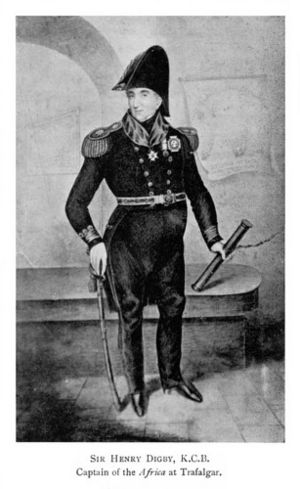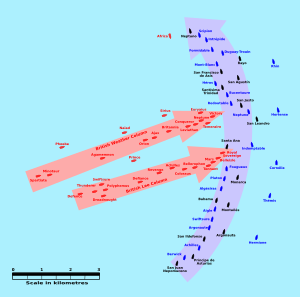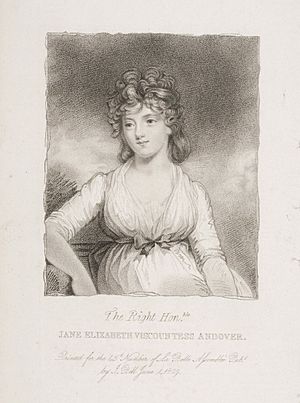Henry Digby (Royal Navy officer) facts for kids
Quick facts for kids
Sir Henry Digby
|
|
|---|---|
 |
|
| Born | 20 January 1770 Bath, England |
| Died | 19 August 1842 Sheerness, Kent, England |
| Allegiance | |
| Service/ |
|
| Rank | Royal Navy Rear-Admiral |
| Commands held | HMS Incendiary HMS Aurora HMS Leviathan HMS Alcmene HMS Resistance HMS Africa Nore Command |
| Battles/wars | French Revolutionary Wars Napoleonic Wars |
| Awards | Knight Grand Cross of the Order of the Bath |
Sir Henry Digby was a brave British naval officer. He served during the French Revolutionary Wars and the Napoleonic Wars. Born in 1770, he came from a family of naval officers. His uncle was the famous Admiral Robert Digby. Henry started his sea career at just 14 years old.
As a young officer, he was praised for saving sailors from a burning ship. He quickly became a commander and then a captain. Digby was known for capturing many enemy ships. He took 57 ships in less than two years! His biggest capture was the treasure ship Santa Brigida in 1799.
Digby commanded HMS Africa at the famous Battle of Trafalgar. He bravely sailed his ship into the enemy fleet. This was against orders from Nelson, who feared his small ship would be destroyed. After the wars, Digby married Lady Jane Elizabeth Coke. They had three children. He continued to serve in the navy and became an admiral in 1841.
Contents
Henry Digby was born in Bath on January 20, 1770. His father was a priest and chaplain to King George III. Henry was one of ten children. Two of his younger brothers also joined the Royal Navy.
Henry began his naval journey very young. In 1783, at age 13, he was listed on ship rosters. He officially went to sea in 1784. His first voyage was to the West Indies aboard HMS Europa.
He quickly moved up from captain's servant to Able Seaman. Soon after, he became a Midshipman. He served on several ships, including the Janus and Salisbury. In 1789, he joined the sloop Racehorse. This ship worked to stop smuggling in the North Sea.
After passing his lieutenant's exam, he became a lieutenant in 1790. He served on HMS Bellerophon and Lion.
In 1793, Digby became first lieutenant of HMS Eurydice. He then moved to HMS Pallas. On May 1, 1795, a huge ship, HMS Boyne, caught fire. It later exploded in Spithead. Digby bravely took a small boat close to the burning ship. He rescued many sailors from the water. This was very dangerous, as the ship's ammunition could explode at any moment.
First Commands and Prize Taking
In August 1795, Digby was promoted to commander. He took charge of the fireship HMS Incendiary. This ship operated in the Channel. In December 1796, he became a Post Captain. He was given command of the 28-gun frigate, Aurora.
Digby's job was to protect British trade ships. He also tried to harm enemy trade. He was very good at capturing enemy vessels. In his first two commands, he captured 57 enemy ships! This earned him a lot of "prize money." Prize money was a share of the value of captured enemy ships and their cargo.
He then joined HMS Leviathan. He helped capture Minorca in November 1798. In 1799, he commanded HMS Alcmene. He captured many small merchant ships. He also took a 28-gun French privateer, Courageux.
Digby was very popular with his crews. He often paid them their share of prize money right away. This meant he always had plenty of volunteers to sail with him. One capture, the Santa Brigida, was incredibly rich. Even a regular sailor received £182 from it.
The Capture of the Santa Brigida
On October 16, 1799, the Alcmene met two British frigates. HMS Naiad and HMS Ethalion were chasing two Spanish frigates. These were the Santa Brigida and Thetis. Digby's ship joined the chase. Soon, a fourth British frigate, Triton, arrived.
The Spanish ships split up. The British ships chased them. After a short fight, Ethalion captured one Spanish ship. Triton led the chase for the second Spanish ship. The next morning, Triton hit some rocks. But it kept chasing the Spanish frigate. Triton and Alcmene then fought the Spanish ship. It surrendered before Naiad could catch up.
The Santa Brigida and Thetis carried huge amounts of treasure. They had about 2.7 million Pieces of Eight. This was worth about £618,000 at the time. In today's money, that would be around £56 million! Digby's share of this treasure was over £40,000. This was a massive amount of money for the time.
Joining Nelson's Fleet
Digby returned to England in 1801. He later took command of HMS Resistance. He captured a French privateer called Elizabeth. This was his last capture before a period of peace.
In July 1805, he was given command of HMS Africa. This was an older, smaller battleship with 64 guns. Many thought it was too small for a major fleet battle. Digby was ordered to join Nelson's fleet. He arrived just days before the Battle of Trafalgar on October 21.
The Battle of Trafalgar
On the morning of the battle, Africa was far from the main British fleet. Bad weather and a missed signal had left Digby's ship isolated. Nelson sent a signal telling Digby to "Make all sail." Nelson wanted him to pull back. He feared Africa would be overwhelmed by the ten larger enemy ships nearby.
Digby, however, bravely decided to join the fight. He sailed Africa towards the British fleet. On his way, he fired at each enemy ship he passed. He then reached the main battle. He found himself near the huge Spanish flagship, the 130-gun Santissima Trinidad.
Digby thought the Spanish ship had surrendered. He sent his first officer, John Smith, to take its surrender. Smith and his men actually reached the Spanish deck! But they quickly realized the ship was still fighting. Luckily, the Spanish admiral allowed Smith's group to return to their boat safely.
As Africa sailed south from the battle, it met the Intrépide. They fought for 40 minutes. Then HMS Orion arrived, and the French ship surrendered. Africa was badly damaged in this fight. It lost 62 men who were killed or wounded. Most of its officers were also hurt.
Years later, a book belonging to Digby was shown on a TV show. It had been hit by a cannonball during the battle! Digby had written inside it: "... this book was shivered in this manner by a whole shot... off Cape Trafalgar on 21 October 1805 ... on board the 'Africa' (64 guns)."
Some people later criticized Digby's actions at Trafalgar. But Nelson's close friend, Hardy, defended him. Hardy wrote that Nelson was "greatly satisfied" with Digby's brave actions.
Later Life and Family
On April 17, 1806, Henry Digby married Lady Jane Elizabeth Coke. She was known for her beauty. They had three children. Their eldest son, Edward St Vincent, later became a Baron. Their daughter, Jane Digby, became a well-known traveler. Their youngest child, Kenelm Henry Digby, became a priest.
For his role at Trafalgar, Digby received more prize money. He also got a government grant. This money, along with his earlier captures, allowed him to live a very comfortable life. In 1815, his uncle, Admiral Robert Digby, passed away. Henry inherited his estate in Minterne Magna. He retired there with his family.
Digby remained in the Royal Navy. He continued to be promoted through the ranks. He became a rear admiral in 1819 and a vice admiral in 1830. He received the Order of the Bath in 1815. He also served as High Sheriff of Dorset in 1835. In 1840, he was appointed Commander-in-Chief, The Nore.
Sir Henry Digby passed away in 1842. He was buried in the local churchyard with his family. At the time of his death, he was a full admiral. He had also become a Knight Grand Cross of the Order of the Bath.
His great-great-granddaughter was Pamela Harriman. She was a famous socialite and diplomat in the 20th century. She grew up on the family estate in Dorset.
Images for kids






